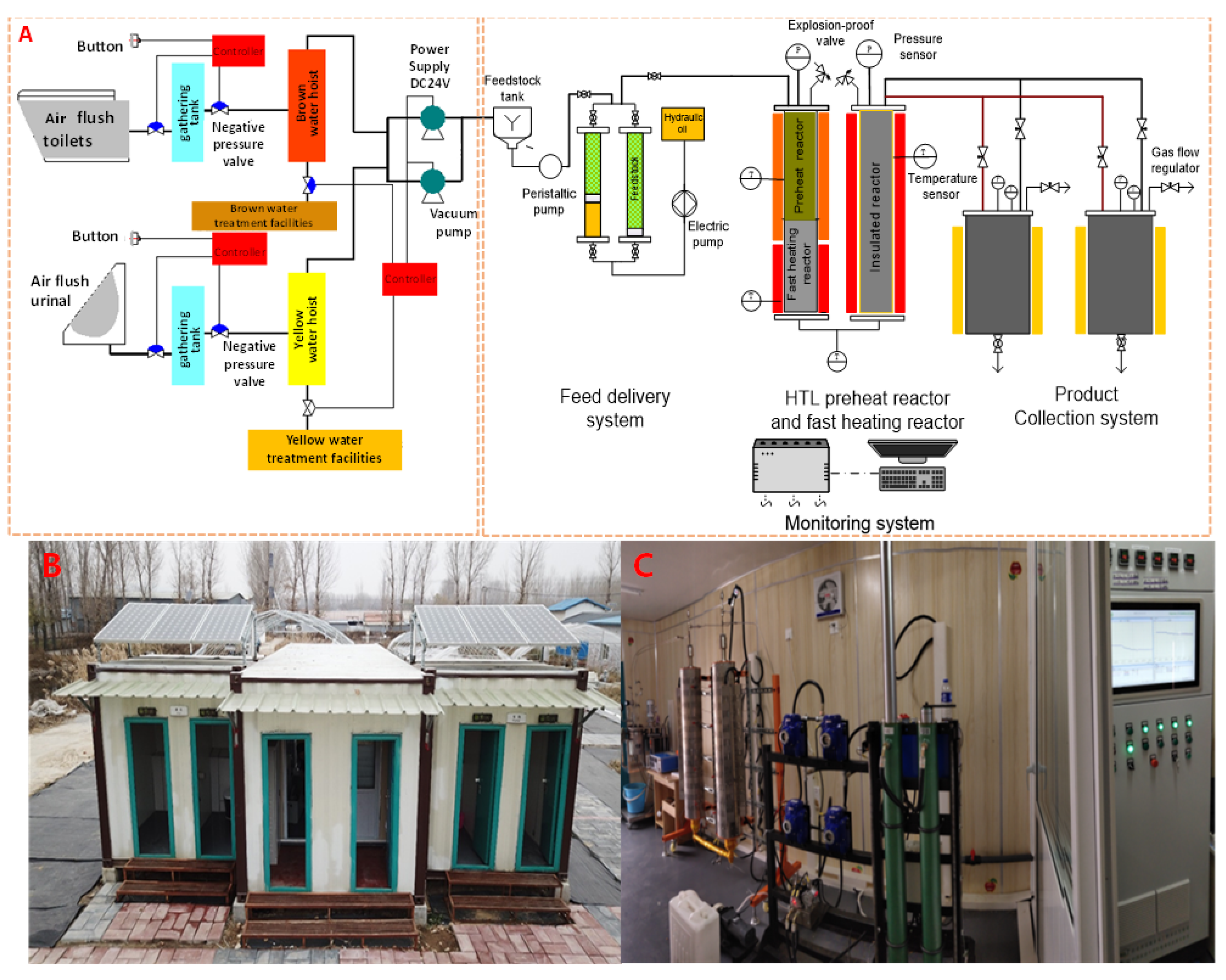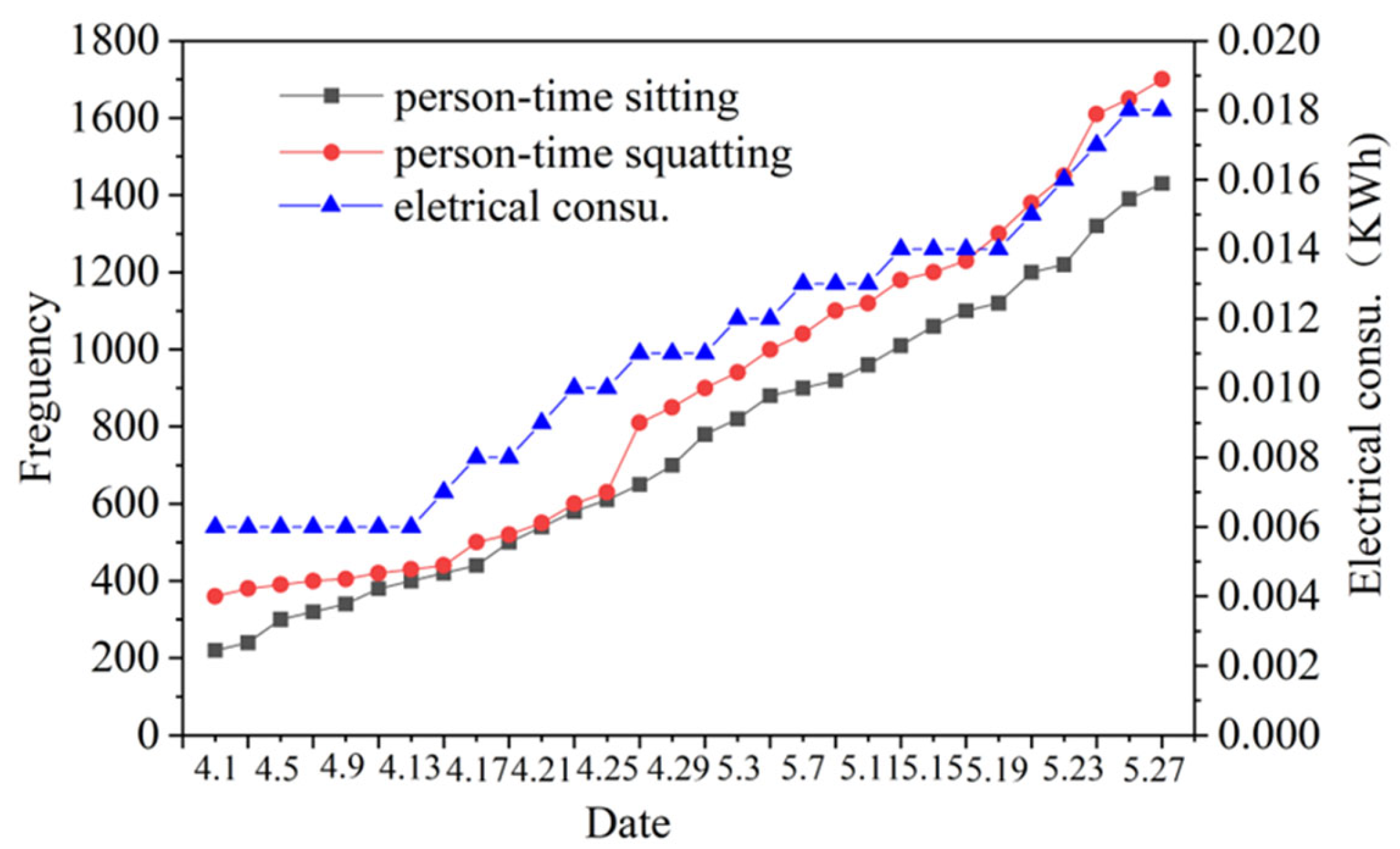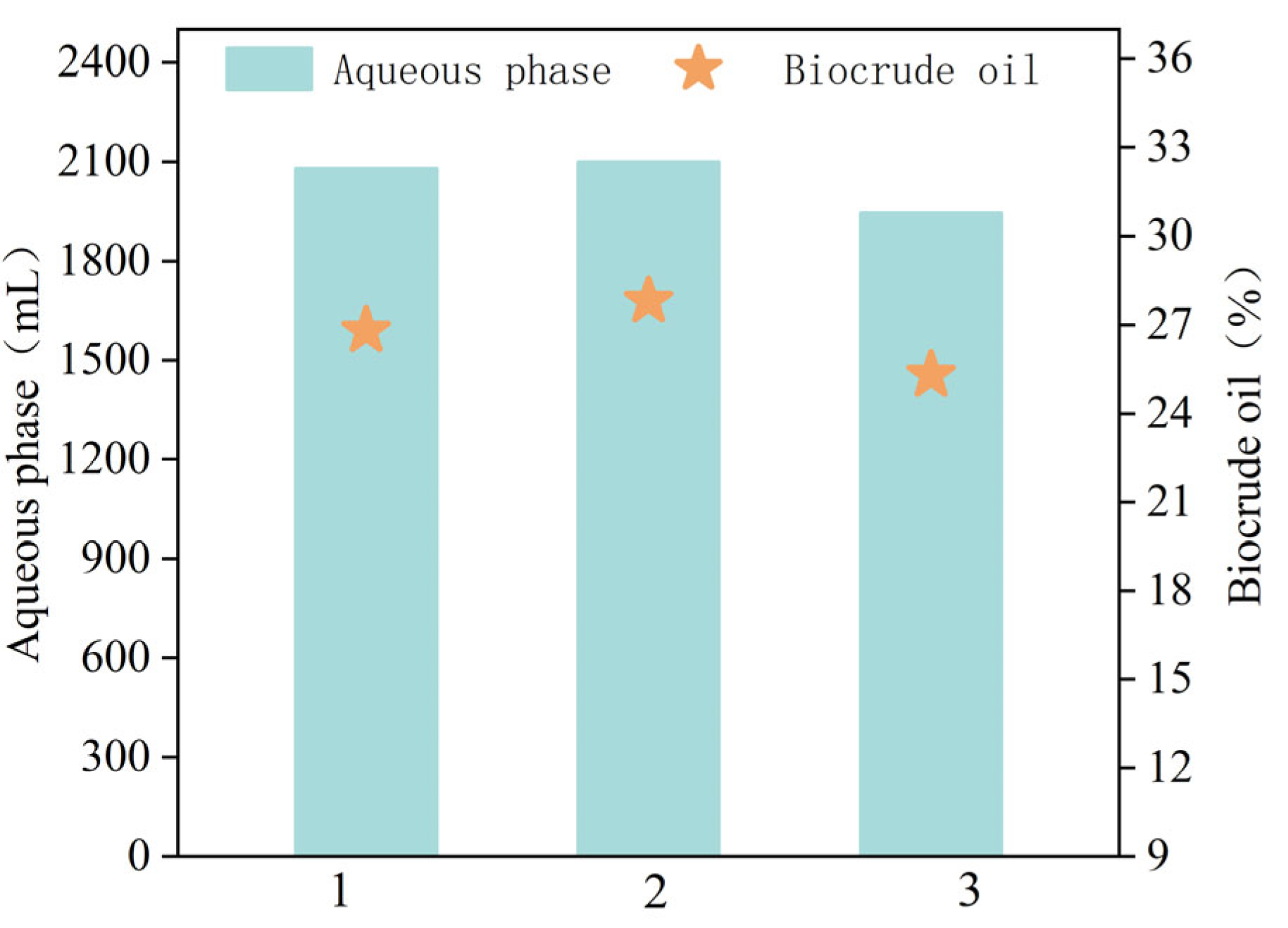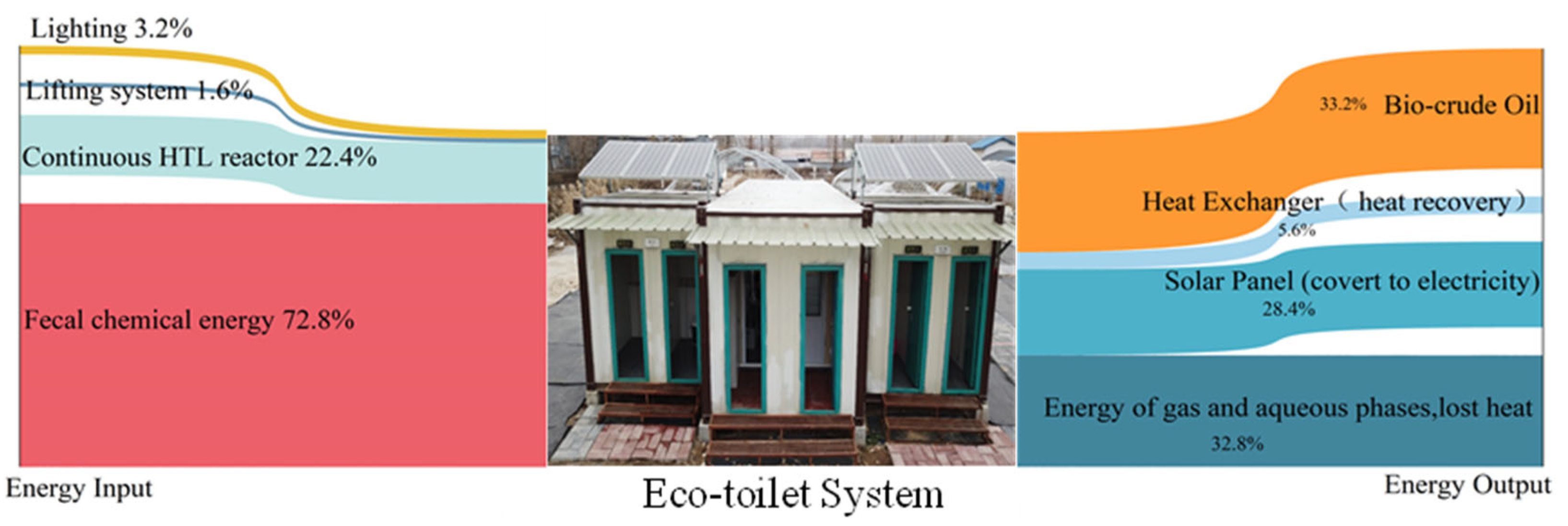An Ecological Toilet System Incorporated with a Hydrothermal Liquefaction Process
Abstract
1. Introduction
2. Materials and Methods
2.1. Feedstock Characterization
2.2. System Design and Operation
2.3. HTL Temperature and Pressure Responses
2.4. Products Separation and Analysis
3. Results and Discussion
3.1. Performance of the Front-End Toilet
3.2. HTL Product Analysis and System Stability Verification
3.3. TC and TN Balance
3.4. Energy Analysis of System
3.5. Performance Comparison of the System
4. Conclusions
Supplementary Materials
Author Contributions
Funding
Institutional Review Board Statement
Informed Consent Statement
Data Availability Statement
Conflicts of Interest
References
- Schouwa, N.L.; Danteravanichb, S.; Mosbaeka, H.; Tjella, J.C. Composition of human excreta-a case study from Southern Thailand. Sci. Total Environ. 2002, 286, 155–166. [Google Scholar] [CrossRef] [PubMed]
- WHO; UNICEF. Progress on Household Drinking Water, Sanitation and Hygiene 2000‒2020: Five Years into the SDGs; WHO: Geneva, Switzerland, 2021; ISBN 9789240030848. [Google Scholar]
- Liu, X.; Li, Z.; Zhang, Y.; Feng, R.; Mahmood, I. Characterization of human manure derived biochar and energy-balance analysis of slow pyrolysis process. Waste Manag. 2014, 34, 19–26. [Google Scholar] [CrossRef] [PubMed]
- Heinonen, H.; Wijk, C. Human excreta for plant production. Bioresour. Technol. 2005, 96, 3–11. [Google Scholar]
- Cheng, S.; Li, Z.; Mohammad, S.; Mang, H.; Zhou, X.; Zhang, J.; Zheng, L.; Zhang, L. Toilet revolution in China. J. Environ. Manag. 2018, 216, 347–356. [Google Scholar] [CrossRef] [PubMed]
- UN. The Sustainable Development Goals Report 2016; United Nations: New York, NY, USA, 2016. [Google Scholar]
- Haq, G.; Cambridge, H. Exploiting the co-benefits of ecological sanitation. Curr. Opin. Environ. Sustain. 2012, 4, 431–435. [Google Scholar] [CrossRef]
- Langergraber, G.; Muellegger, E. Ecological Sanitation da way to solve global sanitation problems? Environ. Int. 2005, 31, 433–444. [Google Scholar] [CrossRef]
- Werner, C.; Panesar, A.; Rüd, S.B.; Olt, C.U. Ecological sanitation: Principles, technologies and project examples for sustainable wastewater and excreta management. Desalination 2009, 248, 392–401. [Google Scholar] [CrossRef]
- Arindam, M.; Anindya, G.; Akshay, R.M.; Ashish, P.; Manickam, S.; Kamal, K.P.; Biswajit, C.; Asim, B. Cross-Linked Porous Polymers as Heterogeneous Organocatalysts for Task-Specific Applications in Biomass Transformations, CO2 Fixation, and Asymmetric Reactions. ACS Sustain. Chem. Eng. 2021, 9, 12431–12460. [Google Scholar]
- Arindam, M.; Deepika, G.; Akshay, R.M.; Kamal, K.P.; Vidha, B.; Chandrani, N.; Saswata, B. Controlled synthesis of Ru-single-atoms on ordered mesoporous phosphine polymers for microwave-assisted conversion of biomass-derived sugars to artificial sweeteners. Nanoscale 2022, 14, 15875–15888. [Google Scholar]
- Kelleher, B.P.; Leahy, J.J.; Henihan, A.M.; O’Dwyer, T.F.; Sutton, D.; Leahy, M.J. Advances in poultry litter disposal technology—A review. Bioresour. Technol. 2002, 83, 27–36. [Google Scholar] [CrossRef]
- Balat, M.; Balat, M.; Kırtay, E.; Balat, H. Main routes for the thermo-conversion of biomass into fuels and chemicals. Part 1: Pyrolysis systems. Energy Convers. Manag. 2009, 50, 3147–3157. [Google Scholar] [CrossRef]
- Tian, C.; Li, B.; Liu, Z.; Zhang, Y.; Lu, H. Hydrothermal liquefaction for algal biorefinery: A critical review. Renew. Sust. Energy Rev. 2014, 38, 933–950. [Google Scholar] [CrossRef]
- Peterson, A.A.; Vogel, F.; Lachance, R.P.; Fröling, M.; Antal, J.M.J.; Tester, J.W. Thermochemical biofuel production in hydrothermal media: A review of sub- and supercritical water technologies. Energy Environ. Sci. 2008, 1, 32–65. [Google Scholar] [CrossRef]
- Toor, S.S.; Rosendahl, L.; Rudolf, A. Hydrothermal liquefaction of biomass: A review of subcritical water technologies. Energy 2011, 36, 2328–2342. [Google Scholar] [CrossRef]
- Gai, C.; Zhang, Y.; Chen, W.; Zhang, P.; Dong, Y. An investigation of reaction pathways of hydrothermal liquefaction using Chlorella pyrenoidosa and Spirulina platensis. Energy Convers. Manag. 2015, 96, 330–339. [Google Scholar] [CrossRef]
- Chen, W.; Zhang, Y.; Zhang, J.; Yu, G.; Schideman, L.C.; Zhang, P.; Minarick, M. Hydrothermal liquefaction of mixed-culture algal biomass from wastewater treatment system into bio-crude oil. Bioresour. Technol. 2014, 152, 130–139. [Google Scholar] [CrossRef]
- Ji, C.; He, Z.; Wang, Q.; Xu, G.; Wang, S.; Xu, Z.; Ji, H. Effect of operating conditions on direct liquefaction of low-lipid microalgae in ethanol-water co-solvent for biooil production. Energy Convers. Manag. 2016, 141, 155–162. [Google Scholar] [CrossRef]
- Demirbas, A. Competitive liquid biofuels from biomass. Appl. Energy 2011, 88, 17–28. [Google Scholar] [CrossRef]
- Lu, J.; Zhang, J.; Zhu, Z.; Zhang, Y.; Zhao, Y.; Li, R.; Watson, J.; Li, B.; Liu, Z. Simultaneous production of biocrude oil and recovery of nutrients and metals from human feces via hydrothermal liquefaction. Energy Convers. Manag. 2017, 134, 340–346. [Google Scholar] [CrossRef]
- Yang, L.; Deng, S.; Li, Y.; Zhang, J.; Wang, H. Effects of process conditions on direct liquefaction of human fecal by Box-Behnken response surface methodology. Renew. Energy Resour. 2016, 34, 1554–1560. (In Chinese) [Google Scholar]
- Wang, W.; Yang, L.; Yin, Z.; Kong SHan, W.; Zhang, J. Catalytic liquefaction of human feces over Ni-Tm/TiO2 catalyst and the influence of operating conditions on products. Energy Convers. Manag. 2018, 157, 239–245. [Google Scholar] [CrossRef] [PubMed]
- Elliott, D.C.; Hart, T.R.; Neuenschwander, G.G.; Rotness, L.J.; Roesijadi, G.; Zacher, A.H. Hydrothermal processing of macroalgal feedstocks in continuous-flow reactors. ACS Sustain. Chem. Eng. 2013, 2, 207–215. [Google Scholar] [CrossRef]
- Marrone, P.A.; Elliott, D.C.; Billing, J.M.; Hallen, R.T.; Hart, T.R.; Kadota, P. Bench-scale evaluation of hydrothermal processing technology for conversion of wastewater solids to fuels. Water Environ. Res. 2018, 90, 329–342. [Google Scholar] [CrossRef] [PubMed]
- Suesse, A.R.; Norton, G.A.; van Leeuwen, J.H. Pilot-scale continuous-flow hydrothermal liquefaction of filamentous fungi. Energy Fuel 2016, 30, 7379–7386. [Google Scholar] [CrossRef]
- Sintamarean, I.M.; Grigoras, I.F.; Jensen, C.U.; Toor, S.S.; Pedersen, T.H.; Rosendahl, L.A. Two-stage alkaline hydrothermal liquefaction of wood to biocrude in a continuous bench-scale system. Biomass Convers. Bior. 2017, 7, 425–435. [Google Scholar] [CrossRef]
- Li, H.; Zhu, Z.; Lu, J.; Watson, J.; Kong, D.; Wang, K.; Zhang, Y.; Liu, Z. Establishment and performance of a plug-flow continuous hydrothermal reactor for biocrude oil production. Fuel 2020, 280, 118605. [Google Scholar] [CrossRef]
- Sun, Z.; Lu, J.; Zhang, T.; Cao, X.; Zhang, K. Research and reflection on the transformation of dry latrines. Sci. Exp. Countrys. 2019, 5, 61–62. (In Chinese) [Google Scholar]
- Fan, S. A first look at vacuum hygiene systems. China Water Wastewater 2001, 27, 72–74. (In Chinese) [Google Scholar]
- Li, H.; Liu, Z.; Zhang, Y.; Li, B.; Lu, H.; Duan, N.; Liu, M.; Zhu, Z.; Si, B. Conversion efficiency and oil quality of low-lipid high-protein and high-lipid low-protein microalgae via hydrothermal liquefaction. Bioresour. Technol. 2014, 154, 322–329. [Google Scholar] [CrossRef]
- Xu, C.; Lad, N. Production of heavy oils with high caloric values by direct liquefaction of woody biomass in sub/near-critical water. Energy Fuel 2008, 22, 635–642. [Google Scholar] [CrossRef]
- Lee, A.; Lewis, D.; Kalaitzidis, T.; Ashman, P. Technical issues in the large-scale hydrothermal liquefaction of microalgal biomass to biocrude. Curr. Opin. Biotech. 2016, 38, 85–89. [Google Scholar] [CrossRef] [PubMed]
- Pedersen, T.H.; Grigoras, I.F.; Hoffmann, J.; Toor, S.S.; Daraban, I.M.; Jensen, C.U.; Iversen, S.B.; Madsen, R.B.; Glasius, M.; Arturi, K.R.; et al. Continuous hydrothermal co-liquefaction of aspen wood and glycerol with water phase recirculation. Appl. Energy 2016, 162, 1034–1041. [Google Scholar] [CrossRef]
- Li, H.; Wang, M.; Wang, X.; Zhang, Y.; Lu, H.; Duan, N.; Li, B.; Zhang, D.; Dong, T.; Liu, Z. Biogas liquid digestate grown Chlorella sp. for biocrude oil production via hydrothermal liquefaction. Sci. Total Environ. 2018, 635, 70–77. [Google Scholar] [CrossRef] [PubMed]
- Tian, C.; Liu, Z.; Zhang, Y.; Li, B.; Cao, W.; Lu, H.; Duan, N.; Zhang, L.; Zhang, T. Hydrothermal liquefaction of harvested high-ash low-lipid algal biomass from Dianchi Lake: Effects of operational parameters and relations of products. Bioresour. Technol. 2015, 184, 336–343. [Google Scholar] [CrossRef]
- Zhang, L.; Lu, H.; Zhang, Y.; Li, B.; Liu, Z.; Duan, N.; Liu, M. Nutrient recovery and biomass production by cultivating Chlorella vulgaris 1067 from four types of post hydrothermal liquefaction wastewater. J. Appl. Phycol. 2016, 28, 1031–1039. [Google Scholar] [CrossRef]
- Zhu, Z. Hydrothermal Liquefaction of Typical Agricultural Waste: Conversion Efficiency and Products Characterization; China Agricultural University: Beijing, China, 2018. (In Chinese) [Google Scholar]
- Guo, F. How to Budget for Plumbing Installations; China Architecture & Building Press: Beijing, China, 1993. (In Chinese) [Google Scholar]
- Beijing Institute of Nuclear Engineeing. Water Supply and Drainage Design Manual; China Architecture & Building Press: Beijing, China, 1986. (In Chinese) [Google Scholar]
- Zhou, J.; Liu, H.; Li, Y. Study on vacuum separate collection and reuse of civic feces, garbage and domestic wastewater. Urban Environ. Urban Ecol. 2002, 15, 10–13. (In Chinese) [Google Scholar]
- Xie, X.; Wang, Y.; Li, X.; Wei, X.; Yang, S. Pickering emulsions stabilized by amphiphilic carbonaceous materials derived from wheat straw. Colloids Surf. A 2018, 558, 65–72. [Google Scholar] [CrossRef]
- Kumar, G.; Shobana, S.; Chen, W.H.; Bach, Q.V.; Kim, S.H.; Atabani, A.E.; Chang, J.S. A review of thermochemical conversion of microalgal biomass for biofuels: Chemistry and processes. Green Chem. 2017, 19, 44–67. [Google Scholar] [CrossRef]
- Lu, J.; Li, H.; Zhang, Y.; Liu, Z. Nitrogen migration and transformation during hydrothermal liquefaction of livestock manures. ACS Sustain. Chem. Eng. 2018, 6, 13570–13578. [Google Scholar] [CrossRef]
- Shi, Q.; Xu, C.; Zhao, S.; Chung, K.H.; Zhang, Y.; Gao, W. Characterization of basic nitrogen species in coker gas oils by positive-ion electrospray ionization fourier transform ion cyclotron resonance mass spectrometry. Energy Fuel 2010, 24, 563–569. [Google Scholar] [CrossRef]
- Zhou, Y.; Schideman, L.; Yu, G.; Zhang, Y. A synergistic combination of algal wastewater treatment and hydrothermal biofuel production maximized by nutrient and carbon recycling. Energy Environ. Sci. 2013, 6, 3765–3779. [Google Scholar] [CrossRef]
- Yu, G.; Zhang, Y.; Schideman, L.L.; Funk, T.L.; Wang, Z. Hydrothermal liquefaction of low lipid content microalgae into bio-crude oil. Trans. ASABE 2011, 54, 239–246. [Google Scholar] [CrossRef]
- Yang, Y.F.; Feng, C.P.; Inamori, Y.; Maekawa, T. Analysis of energy conversion characteristics in liquefaction of algae. Resour. Conserv. Recy. 2004, 43, 21–33. [Google Scholar] [CrossRef]
- Brown, T.M.; Duan, P.; Savage, P.E. Hydrothermal liquefaction and gasification of Nannochloropsis sp. Energy Fuel 2010, 24, 3639–3646. [Google Scholar] [CrossRef]
- Thiruvenkadam, S.; Izhar, S.; Yoshida, H.; Danquah, M.K.; Harun, R. Process application of subcritical water extraction for algal bio-products and biofuels production. Appl. Energy 2015, 154, 815–828. [Google Scholar] [CrossRef]
- Yu, G.; Zhang, Y.; Schideman, L.; Funk, T.; Wang, Z. Distributions of carbon and nitrogen in the products from hydrothermal liquefaction of low-lipid microalgae. Energy Environ. Sci. 2011, 4, 4587–4595. [Google Scholar] [CrossRef]
- Watson, J.; Lu, J.; de Souza, R.; Si, B.; Zhang, Y.; Liu, Z. Effects of the extraction solvents in hydrothermal liquefaction processes: Biocrude oil quality and energy conversion efficiency. Energy 2019, 167, 189–197. [Google Scholar] [CrossRef]
- Ding, N. Experimental Study of Ecological Non-Water Toilet (D); Zhejiang University of Technology: Zhejiang, China, 2008. (In Chinese) [Google Scholar]
- Gao, S.; Lv, M.; Yao, J.; Wang, L.; Wang, G.; Xu, X. Application of combined ecological sanitation toilets in rural areas. J. Shandong Agric. Univ. 2016, 47, 736–739. (In Chinese) [Google Scholar]
- Shi, S. Research on Construction and Operation Characteristics for Waste Disposal System of Rural Toilet; Beijing University of Civil Engineering and Architecture: Beijing, China, 2022. (In Chinese) [Google Scholar]
- Li, Y. Research and Design of Drum Composting Box for Household Manure; Hubei University of Technology: Hubei, China, 2020. [Google Scholar]
- Ouyang, Y. Mobile Toilet Internal Optimization Design Research; Southwest Jiaotong University: Sichuan, China, 2014. (In Chinese) [Google Scholar]
- Yusuf, H.; Pan, X.; Cai, G.; Huang, X.; Ye, Z. Semi-solid anaerobic co-digestion of source-separated fecal slag and food waste: Focusing on methane production, ecological risk assessment, and quality evaluation as fertilizer. Environ. Sci. Pollut. Res. 2022, 29, 66578–66590. [Google Scholar] [CrossRef]
- Castro, A.; Castro, S. Ecological toilet a sustainable alternative for communities in the interior of the Amazon. Nat. Conserv. 2019, 12, 1–10. [Google Scholar] [CrossRef]
Disclaimer/Publisher’s Note: The statements, opinions and data contained in all publications are solely those of the individual author (s) and contributor (s) and not of MDPI and/or the editor (s). MDPI and/or the editor (s) disclaim responsibility for any injury to people or property resulting from any ideas, methods, instructions or products referred to in the content. |







| Parameters | This Research | Literature [3] |
|---|---|---|
| Proximate analysis (%, dw) | ||
| Total solid | 15.89 ± 0.05 | 19.6 ± 3.8 |
| Ash (dw) | 12.50 ± 0.3 | 17.0 ± 1.3 |
| Biochemical analysis (%, dw) | ||
| Cellulose | 21.62 ± 0.45 | / |
| Hemicellulose | 3.68 ± 0.12 | / |
| Lignin | 5.26 ± 0.26 | / |
| Protein | 35.48 ± 0.62 | / |
| Lipid | 13.15 ± 0.21 | / |
| Organic element analysis (%, dw) | ||
| C | 48.34 ± 0.24 | 42.4 ± 1.3 |
| H | 6.59 ± 0.02 | 6.9 ± 0.9 |
| N | 5.17 ± 0.05 | 5.9 ± 1.0 |
| O * | 39.89 ± 0.15 | 43.1 ± 3.1 |
| HHV (MJ/kg) | 22.18 ± 0.08 | 18.1 ± 2.2 |
| Bio-Crude Oil | Solid Residue | Aqueous Phase | |||||||||
|---|---|---|---|---|---|---|---|---|---|---|---|
| C | H | N | O a | HHV | C | H | N | TC | TOC | TN | pH |
| (%) | (%) | (%) | (%) | (MJ/kg) | (%) | (%) | (%) | (g/L) | (g/L) | (g/L) | |
| 74.73 | 8.65 | 5.34 | 11.28 | 35.6 | 31.63 | 3.87 | 2.42 | 25.5 ± 0.21 | 24.34 | 6.89 | 7.69 |
| 75.36 | 8.69 | 4.72 | 11.23 | 35.9 | 31.93 | 4.10 | 2.83 | 23.65 ± 0.08 | 23.45 | 7.54 | 7.98 |
| 75.73 | 9.57 | 4.38 | 10.32 | 36.1 | 30.50 | 3.93 | 2.47 | 23.12 ± 0.04 | 22.65 | 7.67 | 8.21 |
| Toilet Type | Conversion Technology | Processing | Product | Energy | Flushing Method | Sanitation (Sterilization Rate) | Reference |
|---|---|---|---|---|---|---|---|
| Flush-free toilet | Aerobic composting | On-site | Organic fertilizers | / | Water-free flushing | Most | [53] |
| Pit Toilet | Composting | All-in-one | Organic fertilizers | / | No water | Part | [54] |
| Vacuum Toilet | Aerobic composting | On-site | Organic fertilizers | / | No water | Part | [55] |
| Flush Toilet | Septic tank | On-site | Organic fertilizers | / | 4–5 L/time water | Part | [56] |
| Flush-free toilet | Composting | Off-site | Organic fertilizers | / | No water | No treatment | [57] |
| Vacuum Toilet | Composting | Off-site | Organic fertilizers | / | No water | No treatment | [57] |
| Foam Toilet | Composting | Off-site | Organic fertilizers | / | Foam and less water | No treatment | [57] |
| Flush-free toilet | Composting | Off-site | Organic fertilizers | / | Flushing with treated urine | Most | [57] |
| Flush-free toilet | Bacterial decomposition | On-site | CO2, water | / | Flushing with treated urine | Part | [57] |
| Flush Toilet | Anaerobic digestion | Off-site | Biogas | / | 4–5 L/time water | Part | [57] |
| Pit Toilet | Composting | Off-site | Organic fertilizers | / | Organic fertilizers | Part | [57] |
| Vacuum Micro-flush Toilet | Hydrothermal liquefaction | All-in-one | Bio-Crude oil, aqueous phase, gas | 287% | 0.8 L/time water | Complete | This study |
Disclaimer/Publisher’s Note: The statements, opinions and data contained in all publications are solely those of the individual author(s) and contributor(s) and not of MDPI and/or the editor(s). MDPI and/or the editor(s) disclaim responsibility for any injury to people or property resulting from any ideas, methods, instructions or products referred to in the content. |
© 2023 by the authors. Licensee MDPI, Basel, Switzerland. This article is an open access article distributed under the terms and conditions of the Creative Commons Attribution (CC BY) license (https://creativecommons.org/licenses/by/4.0/).
Share and Cite
Kong, D.; Yuan, C.; Cao, M.; Wang, Z.; Zhang, Y.; Liu, Z. An Ecological Toilet System Incorporated with a Hydrothermal Liquefaction Process. Sustainability 2023, 15, 6373. https://doi.org/10.3390/su15086373
Kong D, Yuan C, Cao M, Wang Z, Zhang Y, Liu Z. An Ecological Toilet System Incorporated with a Hydrothermal Liquefaction Process. Sustainability. 2023; 15(8):6373. https://doi.org/10.3390/su15086373
Chicago/Turabian StyleKong, Deliang, Changbin Yuan, Maojiong Cao, Zihan Wang, Yuanhui Zhang, and Zhidan Liu. 2023. "An Ecological Toilet System Incorporated with a Hydrothermal Liquefaction Process" Sustainability 15, no. 8: 6373. https://doi.org/10.3390/su15086373
APA StyleKong, D., Yuan, C., Cao, M., Wang, Z., Zhang, Y., & Liu, Z. (2023). An Ecological Toilet System Incorporated with a Hydrothermal Liquefaction Process. Sustainability, 15(8), 6373. https://doi.org/10.3390/su15086373






